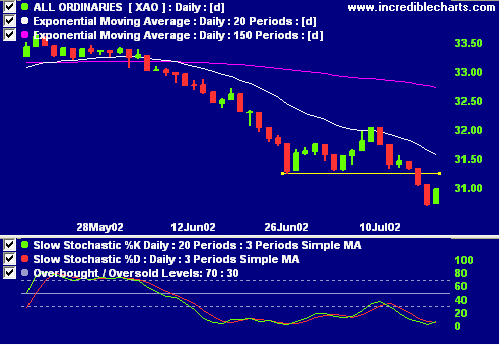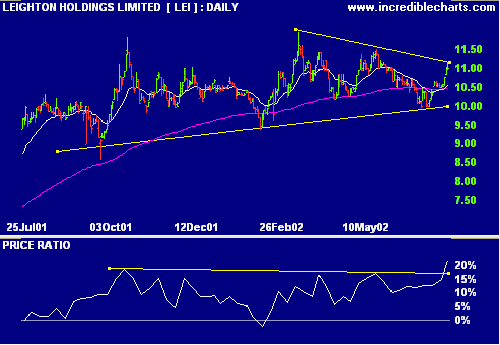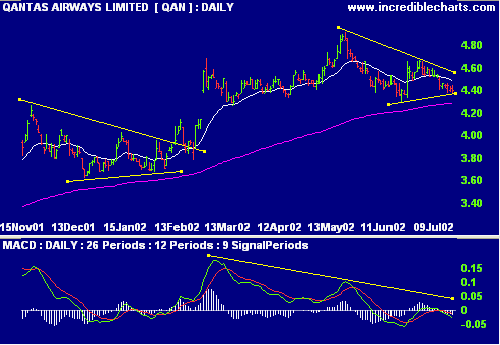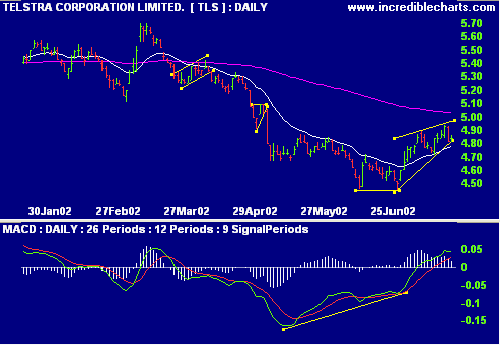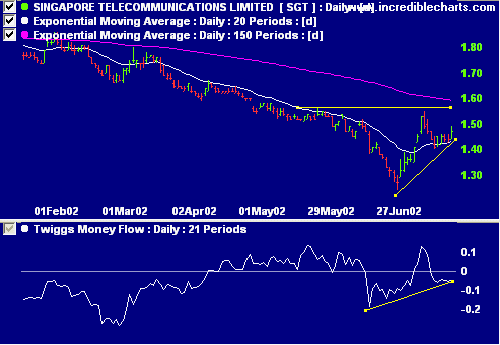Trading Diary
July 18, 2002
These extracts from my daily
trading diary are intended to illustrate the techniques used in
short-term trading and should not be interpreted as investment
advice. Full terms and conditions can be found at Terms
of Use .
USA
The Dow lost a further 1.5% to close at 8409 on
above-average volume. The next key support level is 8000. This is
a
bear market, with primary and secondary cycles trending
down.
The Nasdaq Composite lost 2.9% to close at
1356. The index is at the October 1998 support level.
The primary and secondary cycles are in a down-trend.
The S&P 500 dropped 25 points to close at
881, below the October 1998 support level.
Primary and secondary cycles trend downwards.
Microsoft
Microsoft report fourth-quarter earnings of 43
cents per share, the same as a year ago. (more)
AMD
Advanced Micro Devices reported a second-quarter
loss of 54 cents per share, compared to 5 cents for the same
period last year.
(more)
ASX Australia
The All Ordinaries closed up 27 points at 3100 on average volume.
The primary cycle and secondary cycle
are in a bear trend.
Slow Stochastic (20,3,3) has crossed to above its signal line.
Exponentially-smoothed Money Flow signals distribution.
Aussie dollar
The US dollar weakens along with the equity market.
(more)
Leighton [LEI]
Australia's biggest contractor reports a record $ 8.4 billion of
work in hand.
(more)
The triangle (symmetrical) can either be a continuation or
reversal signal, depending on the breakout. Relative Strength
(price ratio: xao) is positive, while MACD and
exponentially-smoothed Money Flow are neutral.
Qantas [QAN]
Qantas extols the benefits of a partnership with Air New
Zealand, fuelling speculation that QAN will acquire a
substantial stake in the carrier.
(more)
Another triangle: Relative Strength (price ratio: xao) is
positive but MACD and exponentially-smoothed Money Flow are
weak.
Telecom
Not many investors favorite sector at the moment, but worth
watching.
Telstra [TLS] is
approaching the target of 4.98 from the short double-bottom
pattern. The rising wedge is a bearish signal. The
150-day moving average is declining and relative strength
(price ratio: xao) is still weak but MACD and
exponentially-smoothed Money Flow are improving.
Singapore Telecom [STT] shows a bullish, ascending
triangle. A break above 1.55 would have a target of 1.86
(1.55 + (1.55 - 1.24)). The 150-day
moving average is declining and relative strength (price
ratio: xao) is still weak but MACD and
exponentially-smoothed Money Flow are
improving.
Conclusion
Short-term: Avoid new entries. The Slow Stochastic is above,
and MACD below, its signal line.
Medium-term: Wait for the All Ords to signal a reversal.
Long-term: Wait for a bull-trend on the Nasdaq or S&P 500
(primary cycle).
Colin Twiggs
Thought for the Day:
Small investors tend to be pessimistic and optimistic at
precisely the wrong times, so it's self-defeating to try to
invest in good markets and get out of bad ones. - Peter
Lynch
Back Issues
Back
Issues
Access the Trading Diary Archives.
